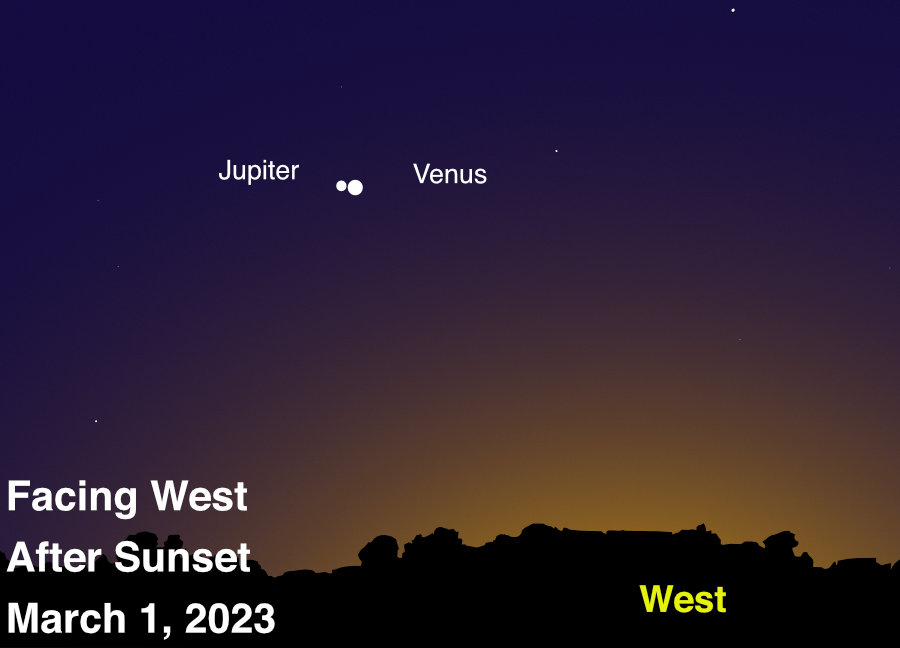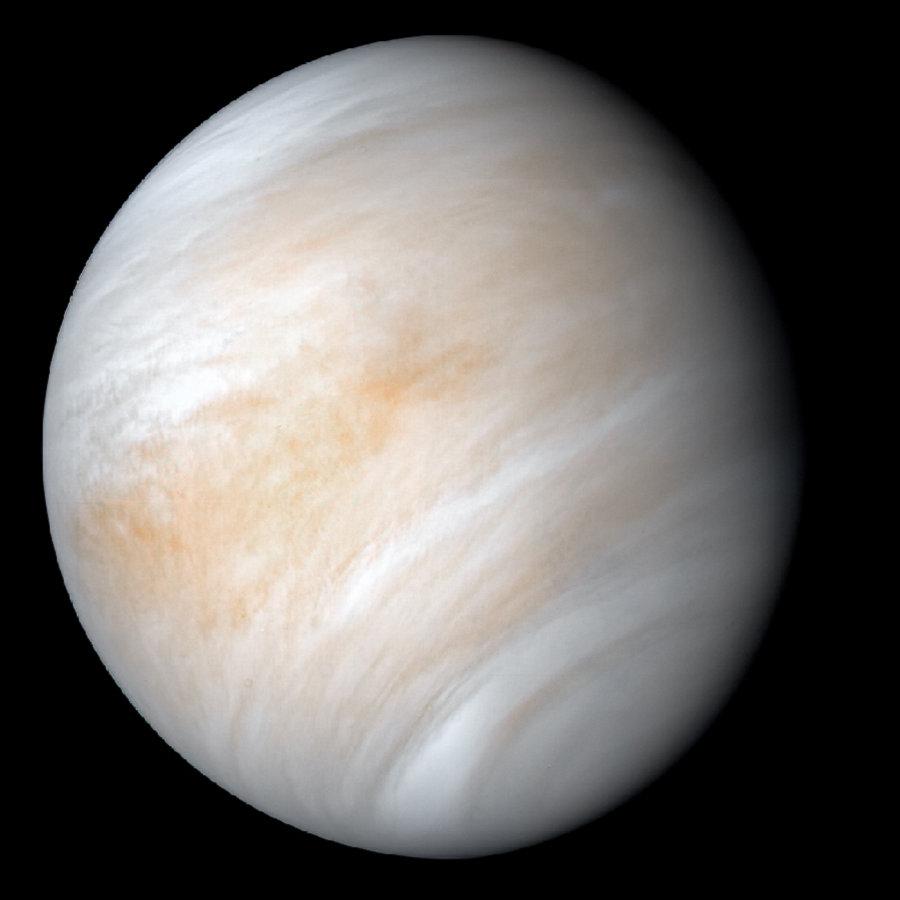Venus is usually the brightest planet in our skies, and is called “Earth’s Twin” due to its similar size to Earth and its rocky composition. However, Venus is a nightmare version of our planet, featuring a thick, crushing atmosphere of acidic clouds, greenhouse gasses, howling winds, and intense heat at its surface.
This rocky inner world’s orbit brings it closer to Earth than any of the other planets, and is the second closest to the Sun after Mercury. Like Mercury, Venus orbits between our planet and the Sun, so Earth-based observers can observe Venus in the morning before sunrise, or in the evening after sunset – but never high in the sky in the middle of the evening, unlike the outer planets. Since Venus is so striking in its twilight appearances, the planet features heavily in sky mythologies worldwide. Venus’s bright morning and evening appearances are the origin for its dual nicknames: the Morning Star, and the Evening Star. Some ancient astronomers never made the connection, and assumed the Evening Star and Morning Star were two unrelated objects! Observers can even spot Venus during the daytime, if the sky is very clear and the planet is bright enough. Venus also has phases, similar to the Moon and Mercury. Galileo’s observations of Venus’s phases helped turn the astronomy world upside down in the early 1600s, and you can see them yourself using a telescope or even a surprisingly low-power pair of binoculars. Warning: Please be very careful when observing Venus with a telescope in the early morning or daytime. Never allow the Sun to enter your instrument’s field of view, as you could be permanently blinded.
Venus’s other moniker of “Earth’s Twin” is a bit misleading. In terms of their surface temperatures and atmospheres, Venus and Earth are extremely different! The surface of Venus is warmer than that of Mercury, despite Mercury being many millions of miles closer to the Sun. While Mercury is still a scorching 800 degrees Fahrenheit (427 degrees Celsius), Venus is even hotter: 900 degrees Fahrenheit (482 degrees Celsius). The vast amount of carbon dioxide in the thick Venusian atmosphere acts as an insulating blanket that retains much of the Sun’s heat, creating the runaway greenhouse effect that dominates its present-day climate. The Venusian surface is a crushing 90 Earth atmospheres on top of its absurd temperatures. These extreme conditions mean that the mission life of any past Venusian robotic landers were measured in hours at best – and usually minutes! However, conditions in Venus’s upper atmosphere may be much more hospitable, with temperatures and pressures at 30 miles (50 km) above the surface that are much more Earth-like in temperature and pressure. Studies of the Venusian atmosphere, including seasonal appearances of dark streaks and faint signals of suggestive chemistry, intrigue researchers with the possibility that some sort of life may persist in its clouds. But far more evidence is needed to confirm such a claim, since non-biological factors like volcanism and other processes could also be the source for these signals.
Venus’s thick sulfuric acid clouds block direct visual observations of its surface from optical telescopes on Earth. Multiwavelength observations from space probes show evidence of active volcanoes and possibly some sort of plate tectonics, but followup missions will be needed to confirm the presence of active volcanism, plate tectonics, and any possible signs of life. In order to do so, NASA is sending two new missions to Venus by the end of this decade: the orbiter VERITAS, which will map the surface in high detail and study the chemistry of its rocks and volcanoes, and DAVINCI+, which will study its atmosphere and possible tectonic surface features via a “descent sphere” that will plunge into Venus’s clouds. Follow their development and discover more about Venus at solarsystem.nasa.gov/venus, and of course, continue your exploration of the universe at nasa.gov.
Venus and Jupiter continue to move closer together in the evening sky this month. Jupiter will continue its descent towards the horizon while Venus will continue to climb and will be visible in the evenings though mid-summer of 2023. It’s a great year for Venus fans!
Image created with assistance from Stellarium
The top layers of Venus’s cloud pop in this contrast-enhanced image, reprocessed with modern techniques from Mariner 10 data.
Credit: NASA/JPL-Caltech
Source: https://solarsystem.nasa.gov/resources/2524/newly-processed-views-of-venus-from-mariner-10/
This article is distributed by NASA’s Night Sky Network (NSN). The NSN program supports astronomy clubs across the USA dedicated to astronomy outreach. Visit nightsky.jpl.nasa.gov to find local clubs, events, and more!



